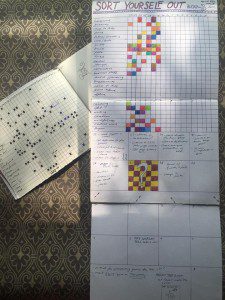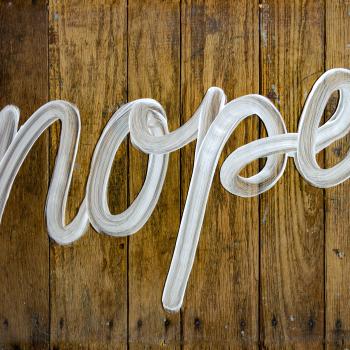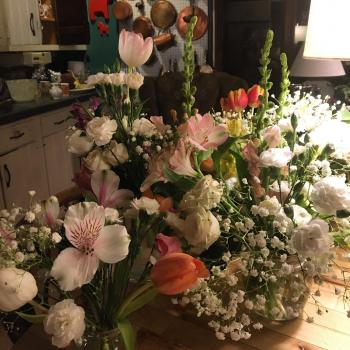In a remarkable and uncharacteristic moment of forethought, I looked down the corridor of time and thought to myself, ‘I might not be able to blog well that week,’ and so provided for myself a slate of blogging friends who would not only pick up my slack but would enrich and better your lives. As I like to say, I’m a giver not a taker. The people who are going to blog here this week are all essential to me in my real life. I am so thrilled to have them post in this place.
First up is Samantha of Rough Edges Life. She is my Spirit Artist. I am entirely her #fangirl. Enjoy!
~~~~~~~~~~~~~~~~~~~~~~~~~~~~~~~~~~~~~~~~~~~~~
When I was a teenager, my room was covered in posters, floor to ceiling. Rearranging them was one of my favorite activities. They were stapled into the wall, and I would ritualistically remove all the staples with a butter knife so I could start fresh. With all the posters in a pile on the floor, I would sort through them, for there were decisions to be made – sometimes one was torn too badly to keep, or I got rid of one because I just “wasn’t into that” anymore. I had posters for The Rocky Horror Picture Show, The Beatles, The Big Chill, The Godfather, Bruce Springsteen, The Breakfast Club, The Kinks…oh, the list could go on and I don’t know why I didn’t keep them. I’ve saved pretty much every other piece of paper from my entire life. They would have made impressive visual aids for when I lectured my kids about how everything was so much better in my day. Anyway, I consider this poster situation to be the awakening of my long-term interest in home and life management. You may think that is a stretch, but through those posters I was introduced to the deep issues of chaos and order in life.
My mother always liked a cluttered aesthetic. She wasn’t a hoarder by any means, but had a lot of knick-knacky things from the thrift store on every flat surface. So naturally, I grew up thinking that when you saw something “cute” (my mother’s catchall adjective) at the thrift store, you bought it and found a place for it among all the other dusty cute things. And so that’s what I did from the time I moved into my first “place” at 18, though at that time my “style” was, by necessity, poverty minimalism (which I do look back on fondly). But even then, I did have some “stuff” that I was attached to. Since the definition of cute differs from person to person, I gravitated towards majorca pottery, antique fountain pens and secondhand books by Bill Moyers and Harold Kushner (rather than the cow plaques and vintage food tins favored by my mother).
A few years later, my main thoughts about things domestic were unfortunately less about self-improvement and too much about other-improvement with “the other” being my husband. After we had our first child, I really and truly made a WALL CHART that was supposed to tell us how “fairly” we were sharing the household work. I think my husband just refused to fill in any of the little squares even when he did wash dishes or something, which is exactly what he should have done, because spite is the appropriate reaction to the kind of shaming control freak who would make such a chart. Talk about something I should have kept for posterity; this thing is it.
About that same time, I read a book called Plain and Simple, by Sue Bender. She was a busy secular person who went to live with an Amish family for a few months, and she found herself drawn into the quiet orderliness of their lives. I remember her saying something about how sweeping the floor, which had always just been a “chore” to her, had become something meaningful. That was probably my first exposure to what we now call mindfulness (which is an important part of my philosophy today but I didn’t quite get it then. But I think I was trying.)
In my 20s and early 30s, I bought into the stereotype that “freewheeling creative people” like myself:
1) thrive in a mess and/or
2) like to live completely free from structure and routine and/or
3) are just so busy making important art that we don’t have time for the mundane tasks of housekeeping, Dahlink.
As I got to know myself better, I had to admit that this whole “unmediated chaos is the hotbed of creativity” thing just didn’t work for me. Probably because, in addition to a lot of cute thrift store acquisitions, I have, over the years, also acquired five children who don’t go to school. In case you are unaware, such profligate breeding of even very cute offspring puts you in a messy, chaotic situation by its very nature. It also leaves very little time for creative pursuits of any kind. What that usually means is that you have lots of unwashed dishes but little actual art to use as an excuse for that.
I admitted that I wanted both clean dishes and at least a moderate creative output, even though such a desire pegged my psuedo-hippie self as embarrassingly bourgeois. So, for the past 15 years or so I have been working to discover whether that elusive balance between chaos and order (which I also call “freedom within form”) even exists as an actual possibility. And if so, how do I get me some?
The idea of chaos and order always makes me think about the first chapter of Genesis, back when things were without form and void, and the Spirit of God hovered there over the waters, thinking about how to whip things into shape. I recently started obsessively listening to psychology professor Jordan Peterson. He’s into mythology, and so I now know that chaos is this huge archetypal thing in which resides potential and the seeds of creativity. It’s positive and necessary to keep our lives and perspectives fresh. But given too much of it, we just find ourselves in a big scary pit where nothing makes sense. We don’t like that. Since we are created in the image of God, we find ways to push back, contain, or transform the chaos (usually with mixed results). In our housekeeping we might buy all these clever little containers to corral our possessions, but the possessions keep multiplying and/or leaving their designated area. In the self-improvement arena, we impose order with schedules, chore charts, healthy eating plans and stuff like that. But chaos always creeps back in, we break our resolutions almost before they are made. We see that as a negative thing, and left unmediated, it probably will be.
But according to Professor Peterson, excessive top-down order leads to tyranny, which is also a problem. Of course, he’s talking about the State and society, but I think most of us have experienced ourselves as personal tyrants and cruel overlords, and we have rebelled when the Inner Dictator orders our lives too strictly. Like, you go on a super low carb diet and then three weeks later you are giving yourself black-market carbs with a hypodermic needle. I am the poster child for this as far as self-improvement goes, and I have a fat manila envelope stuffed full and labeled: Failed Plans and Schedules. And that envelope doesn’t even contain the half of it.
The fact that I failed so often when I tried to “improve” myself led to mild despair over the years. When I felt at my most unimprovable, what was left to me was rearranging my furniture. That isn’t exactly improvement, but at least it’s novelty (at times a semi-appropriate substitute).
About five years ago, I discovered Mockingbird and the very helpful term, low anthropology. A low anthropology assumes that by (sinful) nature, humans aren’t all that adept at making and/or maintaining positive change. This made me feel somewhat less depressed about my failures, but my interest in self-improvement and “personal growth” continued unabated, which was kind of a paradox because those two ideas seem somewhat incompatible. Then one day I was reading a book by Natalie Goldberg which I had read many times before. Somehow I had missed this story she tells about her whiny Jewish self, complaining to her zen teacher about who knows what. (I perked up at this since my whiny Jewish self has done a lot of complaining over the years.) His calm zen response to her pity party was simply, “make positive effort for the good”. My interest was piqued. This little statement seemed to be a workable way for me to reconcile low anthropology and the seemingly universal human tendency to “strive”. It works in just about any life situation, which is a strong enough hypothesis for a non-scientist like me to consider it as relevant.
MPE4TG takes into consideration all our human weaknesses and limitations. The depressions that come upon us, our limited time and energy and the fragility of our bodies, and even our sheer laziness. Sometimes (let’s be honest and say usually) we can’t manage something heroic, but we can manage just this one little thing, we can make a teeny tiny positive effort for the good.
I keep a habit chart, to track these little efforts.
It has really become the main tool of my three-decades-long chaos and order experiment. And it is proving true my suspicion, that doing something for even a small amount of time, on a regular basis, adds up in a kind of exponential way. For example, I do 12 knee pushups every day. I can do full pushups but I’m phoning it in at this season of life. That’s it for “upper body workout”. But my 48 year old arms have no flapping triceps. I didn’t expect that. My triceps look almost as good as they did when I was doing P90x 5 times a week. But I digress…away from my triceps and back to the habit chart:
The habit chart imposes order – you are thinking about your “ideal behavior” and tracking your “progress” in a systematic way. It allows you to see maybe two weeks of time “at a glance”. This can be sobering but also educational: why is something important to you, or you say it is, but all you see are a fortnight of blank squares? I don’t lie to myself in my habit tracker, which may be its most significant contribution to my life. It’s painful to acknowledge when I’m just not walking the walk (however you would define that), but I assume it is useful information for becoming a more well-integrated human being. I keep track of my bad habits too.
A habit chart also has a fun element of chaos and spontaneity in the easy requirements (like literally, do 12 knee pushups and you get to fill in the “strength” square! Don’t set the bar too high on this.) And the day-to-day freedom to choose whether to do a certain thing helps keep the Inner Rebel at bay – plus she calms down when coloring in the squares with her favorite colored pencils or watercolors.
I’m not sure how I began with posters and ended up at habit charts. I think I had a different trajectory in mind at the beginning. Can I bring it full circle somehow, so your eyes don’t start glazing over?
Final Thoughts Which Will Hopefully Have Some Utility For You:
– Keep your posters.
– Pass up most of the cute knickknacks at the thrift store.
– Don’t make charts for your husband to fill out like he is a child, but make a habit chart for yourself and learn to use it. Email me with any questions you have about doing that, I’d love to help you.
– Both chaos and order are necessary. We need stability, comforting routine, ritual and all that. But we don’t want to be bored, either. We hate being bored. Dipping the toe or maybe going wading in the shallow end of chaos is a good boredom buster. Step outside your comfort zone and do creative things or do mundane things in a creative way or with a fresh mindset. But as we know, chaos isn’t always fun and games. Eventually you will be thrown into the deep chaos of life itself, which unfortunately includes death and pain and suffering of all kinds. Something you didn’t ask for and which doesn’t feel creative at all and you only wish you could go back to the boredom of excessive routine. When you find yourself there, you can mediate the chaos by starting a journal based creative practice. Sketching, writing, reminiscing, making lists, praying, complaining in book format is a powerful psychological ordering structure, plus you wind up with a ready-made legacy for your loved ones when you kick the bucket and/or are ushered into Glory.
If you want to read more of my chaotic thoughts being somewhat ordered in writing, please read my blog.
If you are interested in and/or need “encouragement, creative resources and gentle self-improvement for the tired and somewhat jaded optimist”, please sign up for my email list at Rough Edges Life. That site is still under construction, but will eventually offer online courses, creative tutorials, paper zines and blog posts on…well, I haven’t narrowed that down yet. But if you liked this post, there will likely be something there for you. Also, a podcast called, yes, Make Positive Effort For The Good.
And finally – Anne, I am your biggest fangirl and it has been an honor to appear in Preventing Grace!













